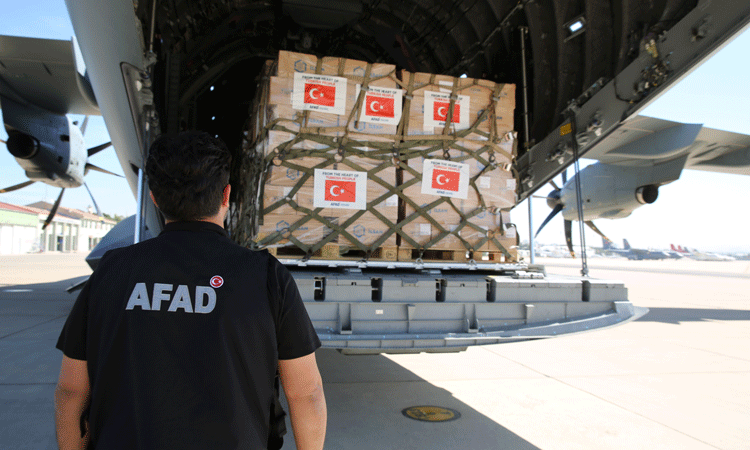Dancing on shaky ground
- Like
- Digg
- Del
- Tumblr
- VKontakte
- Buffer
- Love This
- Odnoklassniki
- Meneame
- Blogger
- Amazon
- Yahoo Mail
- Gmail
- AOL
- Newsvine
- HackerNews
- Evernote
- MySpace
- Mail.ru
- Viadeo
- Line
- Comments
- Yummly
- SMS
- Viber
- Telegram
- Subscribe
- Skype
- Facebook Messenger
- Kakao
- LiveJournal
- Yammer
- Edgar
- Fintel
- Mix
- Instapaper
- Copy Link
Posted: 17 November 2023 | Erdal Kiziltas | No comments yet
Writing exclusively for International Airport Review Erdal Kiziltas, Air Traffic Controller at Turkey’s State Airports Authority (DHMI), details the importance airports have in providing assistance to countries experiencing natural disasters.


Turkey is located in a geographical region which overlay fault lines prone to tectonic shifts and jolts, which can damage infrastructure. The country’s intricate tectonic plate interactions have created multiple fault lines that generate seismic activity. As a consequence of these complex interactions, the country has experienced numerous devastating earthquakes throughout its history, resulting in significant loss of life and damage.
Unleashing hope from the skies
Aviation Stakeholders in Turkey rapidly provided aid and assistance to the general directorate of state airports authority (DHMI) and the Disaster and Emergency Management Presidency (AFAD) in coordination with air traffic control service units and airports following the 7.8 magnitude earthquake that struck the country, in the early hours of 6 February 2023. It caused widespread destruction and many losses of life. Air operations have proven to be crucial in swiftly transporting emergency personnel following the disaster, as well as effectively evacuating tens of thousands of victims and stranded individuals in severely impacted regions. It is a race against time for rescue workers as people trapped under rubble need immediate assistance.
Shaking up the city of dreams
Acknowledging the high possibility of an earthquake occurring in Istanbul is essential. Istanbul is located in a seismically active region known as the North Anatolian fault zone, which runs across the northern part of the country. This fault zone is associated with the convergence of the Eurasian and Anatolian tectonic plates, making the region prone to earthquakes. An earthquake of substantial magnitude in Istanbul would have severe consequences, both in terms of loss of life and infrastructure damage. The high population density and inadequate urban planning exacerbate the risks, making Istanbul particularly susceptible to casualties and destruction. Additionally, the impact on critical infrastructure, including hospitals, transportation networks, and utilities, would bring the city to a standstill, hampering rescue and recovery efforts. In light of the significant seismic activity in Istanbul, it is paramount to comprehend the possible repercussions, readiness strategies, and the city’s ability to withstand such a disaster.
The crucial role of airports
Airports play a crucial role in disaster management and response because of their infrastructure, resources, and connectivity. In times of crisis, airports serve as invaluable lifelines, facilitating rescue operations, providing aid and relief, and connecting affected regions with the rest of the world. Immediate response, rapid assessment, and efficient coordination can make all the difference in saving lives and minimising the impact. In this regard, airports can be utilised effectively during disasters. Here’s how:
- Emergency evacuation and shelter: airports can serve as evacuation centres for people affected by disasters. Their indoor areas and amenities are spacious enough to host a considerable number of people. Temporary shelters, medical facilities, and food distribution points can be set up at the airport to provide essential services to displaced individuals.
- Logistical hub: airports can serve as logistical hubs for receiving and distributing relief supplies. Organisations providing aid can utilise the airport’s infrastructure to transport essential supplies like food, water, medical equipment, and other necessities. These supplies can then be organised and dispatched to affected areas efficiently.
- Airlift operations: airports are fully prepared to manage extensive airlift operations. In the aftermath of a disaster, aircraft can transport emergency responders, medical teams, and supplies to the affected area. Additionally, injured individuals can be airlifted to hospitals and medical facilities.
- Communication and coordination: airports often have robust communication systems in place, including radio networks and control towers. These systems can coordinate disaster response efforts, facilitate communication between various agencies, and provide real-time updates on the situation.
- Airborne surveillance and assessment: aircraft based at or near the airport can conduct aerial surveys to assess the extent of damage caused by the disaster. This information is crucial for prioritising response efforts and allocating resources effectively.
- Search and rescue operations: airports can serve as a search and rescue operations base. Helicopters and aircraft can be deployed from the airport to search and rescue individuals stranded in remote or inaccessible areas.
- Medical response: airports often have medical facilities and personnel on-site. In the event of a disaster, these facilities can be expanded to provide emergency medical care to survivors. Additionally, medical evacuation flights can be coordinated from the airport to transport critically injured individuals to hospitals.
- Coordination centre: airports can be used as command and coordination centres for disaster response. Representatives from various government agencies, NGOs, and international organisations can gather at the airport to coordinate their efforts and ensure a unified response.
- Transport of personnel: airports can facilitate the movement of emergency responders, volunteers, and experts to the disaster-affected area. This is essential for rapidly deploying skilled personnel to provide specialised assistance.
- Information and assistance: airports can set up information desks to provide survivors with information about available services, transportation options, and reunification processes for families separated during the disaster.
To effectively utilise airports during disasters, it is imperative to engage in careful planning, coordination, and collaboration among multiple stakeholders, such as government agencies, aviation authorities, aid organisations, and local communities. The nature of the disaster, national regulations, and safety concerns will all play a role in dictating how airports can be used in each situation. By acknowledging and investing in airports’ disaster management capabilities, we can better prepare ourselves to navigate crises with enormous success.


Turkey is one of the European level’s primary contributors to daily air traffic, particularly in the complex airspace Ankara ACC manages. Erdal expertly handles aircraft flights within controlled airspace to ensure safety and efficiency throughout all phases of flight. Erdal’s readiness to manage high-traffic airspace reflects his confidence in upholding the highest traffic safety and efficiency standards.
After the recent earthquake in southeastern Turkey, Erdal has shifted his focus to a critical project centred on collaborative management of air operations and coordination during natural disasters.


















